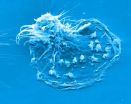(Press-News.org) Glaciers in the tropical Andes have been retreating at increasing rate since the 1970s, scientists write in the most comprehensive review to date of Andean glacier observations. The researchers blame the melting on rising temperatures as the region has warmed about 0.7°C over the past 50 years (1950-1994). This unprecedented retreat could affect water supply to Andean populations in the near future. These conclusions are published today in The Cryosphere, an Open Access journal of the European Geosciences Union (EGU).
The international team of scientists – uniting researchers from Europe, South America and the US – shows in the new paper that, since the 1970s, glaciers in tropical Andes have been melting at a rate unprecedented in the past 300 years. Globally, glaciers have been retreating at a moderate pace as the planet warmed after the peak of the Little Ice Age, a cold period lasting from the 16th to the mid-19th century. Over the past few decades, however, the rate of melting has increased steeply in the tropical Andes. Glaciers in the mountain range have shrunk by an average of 30-50% since the 1970s, according to Antoine Rabatel, researcher at the Laboratory for Glaciology and Environmental Geophysics in Grenoble, France, and lead author of the study.
Glaciers are retreating everywhere in the tropical Andes, but the melting is more pronounced for small glaciers at low altitudes, the authors report. Glaciers at altitudes below 5,400 metres have lost about 1.35 metres in ice thickness (an average of 1.2 metres of water equivalent [see note]) per year since the late 1970s, twice the rate of the larger, high-altitude glaciers.
"Because the maximum thickness of these small, low-altitude glaciers rarely exceeds 40 metres, with such an annual loss they will probably completely disappear within the coming decades," says Rabatel.
The researchers further report that the amount of rainfall in the region did not change much over the past few decades and, therefore, cannot account for changes in glacier retreat. Instead, climate change is to blame for the melting: regional temperatures increased an average of 0.15°C per decade over the 1950-1994 period.
"Our study is important in the run-up to the next IPCC report, coming out in 2013," says Rabatel. The Intergovernmental Panel on Climate Change (IPCC) has pointed out that tropical glaciers are key indicators of recent climate change as they are particularly sensitive to temperature changes. The tropical Andes host 99% of all tropical glaciers in the world, most of them in Peru.
The research is also important to anticipate the future behaviour of Andean glaciers and the impact of their accelerated melting on the region. "The ongoing recession of Andean glaciers will become increasingly problematic for regions depending on water resources supplied by glacierised mountain catchments, particularly in Peru," the scientists write. Without changes in precipitation, the region could face water shortages in the future.
The Santa River valley in Peru will be most affected, as its hundreds of thousands of inhabitants heavily rely on glacier water for agriculture, domestic consumption, and hydropower. Large cities, such as La Paz in Bolivia, could also face shortages. "Glaciers provide about 15% of the La Paz water supply throughout the year, increasing to about 27% during the dry season," says Alvaro Soruco, a Bolivian researcher who took part in the study.
In their comprehensive review of Andean glaciers, the scientists synthesised data collected over several decades, some dating as far back as the 1940s. "The methods we used to monitor glacier changes in this region include field observations of glacier mass balance, and remote-sensing measurements based on aerial photographs and satellite images for glacier surface and volume changes," explains Rabatel.
The study takes into account data collected for glaciers in Colombia, Ecuador, Peru and Bolivia, covering a total of almost a thousand square kilometres. This corresponds to about 50% of the total area covered by glaciers in the tropical Andes in the early 2000s.
The research was conducted to provide the scientific community with a comprehensive overview of the status of glaciers in the tropical Andes and determine the rate of retreat and identify potential causes for the melting. But the authors hope the results can have a wider impact.
"This study has been conducted with scientific motivations, but if the insight it provides can motivate political decisions to mitigate anthropogenic impact on climate and glacier retreat, it will be an important step forward," Rabatel concludes.
### Note
Glacier mass balance is the difference between ice accumulation and ablation (melting and sublimation) in a glacier. Scientists express the annual mass balance in metre water equivalent (m w.e.). A loss of 1.2 m w.e. corresponds to a reduction of about 1.35 metres in ice thickness.
Unprecedented glacier melting in the Andes blamed on climate change
2013-01-22
ELSE PRESS RELEASES FROM THIS DATE:
How can evolutionary biology explain why we get cancer?
2013-01-22
Over 500 billion cells in our bodies will be replaced daily, yet natural selection has enabled us to develop defenses against the cellular mutations which could cause cancer. It is this relationship between evolution and the body's fight against cancer which is explored in a new special issue of the Open Access journal Evolutionary Applications.
"Cancer is far from a single well-defined disease which we can identify and eradicate," said Dr Athena Aktipis, Director, Human and Social Evolution, Center for Evolution and Cancer at the University of California, San Francisco. ...
Children with egg allergies can safely receive flu vaccine, U-M study says
2013-01-22
Ann Arbor, Mich. — Egg allergic children, including those with a history of anaphylaxis to egg, can safely receive a single dose of the seasonal influenza vaccine, according to a new study from the University of Michigan.
Historically, the CDC recommended that the seasonal influenza vaccine not be administered to egg allergic children. Recent research conducted at the University of Michigan, and elsewhere, helped modify this recommendation in 2011 so that caution was warranted for only those with severe egg allergy.
The new study, published in the Annals of Allergy, ...
Hypertension during pregnancy increases risk of end-stage renal disease
2013-01-22
Women with hypertensive disorders in pregnancy are at higher risk of chronic kidney disease and end-stage renal disease compared with women without the disorders, according to a study in CMAJ (Canadian Medical Association Journal).
"We found that women with hypertensive disorders during pregnancy were at higher risk of end-stage renal disease than women without complicated pregnancies," writes Dr. I-Kuan Wang, Division of Nephrology, China Medical University Hospital, Taichung, Taiwan, with coauthors.
Hypertensive disorders such as gestational hypertension and preeclampsia ...
Antibacterial agent used in common soaps found in increasing amounts in freshwater lakes
2013-01-22
When people wash their hands with antibacterial soap, most don't think about where the chemicals contained in that soap end up. University of Minnesota engineering researchers do.
A new University of Minnesota study determined that the common antibacterial agent, called triclosan, used in soaps and many other products is found in increasing amounts in several Minnesota freshwater lakes. The findings are directly linked to increased triclosan use over the past few decades.
In addition, the researchers found an increasing amount of other chemical compounds, called chlorinated ...
Paradise found for Latin America's largest land mammal
2013-01-22
NEW YORK (January 22, 2012) —Wildlife Conservation Society scientists have documented a thriving population of lowland tapirs – the strange forest and grassland-dwelling herbivore with the trunk-like snout – living in a network of remote national parks spanning the Peru-Bolivia border.
Using a combination of camera traps, along with interviews with park guards and subsistence hunters, WCS estimates at least 14,500 lowland tapirs in the region. The population bridges five connected national parks in northwest Bolivia and southeastern Peru.
The WCS findings were described ...
Immune system molecule with hidden talents
2013-01-22
This press release is available in German.
Dendritic cells, or DCs for short, perform a vital role for the immune system: They engulf pathogens, break them down into their component parts, and then display the pieces on their surface. This in turn signals other immune cells capable of recognizing these pieces to help kick-start their own default program for fighting off the invaders. In order to do their job, the DCs are dependent upon the support from a class of immune system molecules, which have never before been associated with dendritic cells: antibodies, best ...
New research on military traumatic brain injury
2013-01-22
Philadelphia, Pa. (January 22, 2013) – Researchers are making new strides in understanding the health consequences and treatment and rehabilitation needs of combat veterans and other service members affected by traumatic brain injury (TBI). The January-February issue of The Journal of Head Trauma Rehabilitation, official journal of the Brain Injury Association of America, is a special issue devoted to new research in military TBI. The journal is published by Lippincott Williams & Wilkins, a part of Wolters Kluwer Health.
"For the second consecutive year, we've expedited ...
New information on binding gold particles over metal oxide surfaces
2013-01-22
The strong binding of gold on electronically modified calcium oxide can now be understood in detail. In a computational study, researchers Jenni Andersin, Janne Nevalaita, Karoliina Honkala and Hannu Häkkinen at the University of Jyväskylä Nanoscience Center have shown how redox chemistry entirely determines the adsorption strength of gold on the modified oxide where one metal atom is replaced with molybdenum. The study was funded by the Academy of Finland.
The research team applied the so-called Born-Haber cycle to analyse how different terms contribute to adsorption ...
The Nurse Practitioner marks 25th Annual Legislative Update
2013-01-22
Philadelphia, Pa. (January 22, 2013) – The most comprehensive review of new legal and regulatory issues affecting advanced nursing practice across the United States is now available in the "25th Annual Legislative Update," presented exclusively by The Nurse Practitioner: The American Journal of Primary Healthcare. The Nurse Practitioner is published by Lippincott Williams & Wilkins, a part of Wolters Kluwer Health.
Compiled by Susanne J. Phillips, MSN, FNP-BC, the annual supplement presents a comprehensive review of the legislative proceedings, bills, and laws pertaining ...
South Americans want policy makers to put ethics above price
2013-01-22
Researchers at Royal Holloway university have found that Brazilians and Chileans want the state to buy on social and environmental criteria, not just on price.
Based on this pioneering research, researchers from Royal Holloway have been invited to be the first academics to join the UN Environmental Programme's global Sustainable Public Procurement Initiative and attend its meeting in Paris this week.
The Choices Project is a collaboration between Royal Holloway, the Universidade Federal do Rio de Janeiro and Universidad Diego Portales. The project team also involves ...



